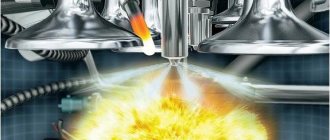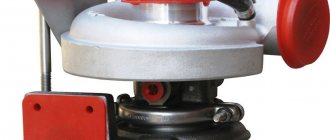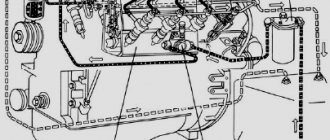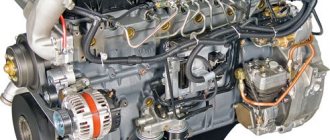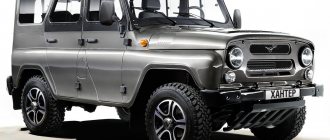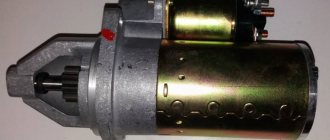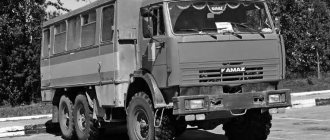The fuel system of trucks has undergone significant changes since the beginning of its development. The once popular in-line fuel pump has long been replaced by electronic systems, and the modern injector is significantly different from its predecessor. In this article we will not delve far into history to the times of the founder Rudolf Diesel, but will go back only three decades ago. Due to their economy, high efficiency and high power, diesel engines have received universal approval and are widely used in trucks, industrial and marine engines. Let's start our introduction to truck fuel systems with the in-line fuel pump.
Repair procedure for Scania pump injectors
Issues discussed in the material:
- Interesting facts about
- Why Scania injectors can fail
- What are the main symptoms of a faulty Scania injector?
- How to repair Scania pump injectors
- Which Scania injectors are better, according to car owners - PDE aphids HPI
Sometimes there is a need to repair Scania injectors. Yes, this Swedish company today is perhaps the best manufacturer of freight transport in the world. But even the most reliable equipment breaks down over time.
And if this happens, the driver simply needs to know what signs indicate injector failure and what should be done in such a situation.
A few words about
The Swedish company Scania was founded in 1891. Over more than a century of history, more than 1,400 thousand trucks and buses have rolled off its assembly lines, currently used in all countries of the world.
Today Scania is one of the largest manufacturers of trucks and buses. Another important area of its activity is the manufacture of industrial and marine diesel engines. The company directs all resources to the development of production; this is its main difference from similar automakers.
Scania is not afraid of economic crises: as practice has shown, even in difficult years for truck manufacturers, the Swedish giant has always received high profits. Scania means reliability and quality of diesel engines in all corners of the globe, even in the most adverse conditions!
In addition to Sweden, the concern's production facilities are currently based in countries such as France, the Netherlands, Argentina, Brazil, Poland, and Russia. There are 11 Scania factories in total. Their products received the prestigious international “Truck of the Year” awards in 2004 and 2009.
Diesel engines with the Scania logo fully meet all modern environmental requirements. Currently they are equipped with high-tech unit injectors from Cummins and Bosch.
Why Scania injectors can fail
The impeccable, repeatedly confirmed quality of Scania trucks and the parts from which this equipment is made does not, however, guarantee their endless operation. The condition of the same pump injectors during use depends on the oil and fuel used.
Now Scania is equipped with two types of pump injectors:
- Scania HPI is a mechanical pump injector from Cummins (high pressure HPI injector). It consists of two fuel volume actuators (valves); two injection advance actuators (valves); the pump injectors themselves;
- Bosh electronic pump injector (PDE).
If malfunctions in the operation of these parts are identified, it is recommended that you first contact specialized services that have the appropriate equipment, since in any situation repairs are preceded by detailed diagnostics. In services it is produced at a special stand. All components are tested under various engine loads. It is advisable to carry out such a check regularly, without leading to breakdowns.
Scania electronic pump injectors are equipped with mechanical components, which, unfortunately, are not immune to natural wear and damage. The valve assembly is the most vulnerable to breakdowns, because it takes on the greatest load during engine operation. The sprayer is also often prone to breakdowns. Third place in this anti-rating goes to the electromagnetic part and plunger. It is rare, but it happens that the housing or spring breaks.
We recommend
Note that most of the breakdowns would not have occurred if good fuel had been used. It very carefully controls the quality of component parts: for example, the gap sizes of the electromagnetic part components do not exceed two microns. The tightness of the valve can be damaged by mechanical particles contained in insufficiently high-quality fuel (in high-quality fuel they are negligible). In the presence of damage and leakage, engine power decreases and fuel consumption increases. The troubleshooting process allows you to identify damage caused by particles of low-quality fuel.
Certain problems can be solved by cleaning or replacing parts of the unit injector without having to replace the entire part. In other situations this cannot be avoided. The range of both original and similar injectors on the market is quite wide.
Fuel systems with pump injectors
The next stage in the development of fuel systems was pump injectors. A similar system can be found with the abbreviation PDE. From the usual fuel system, only the booster pump remains, although the fuel pressure created by it has approximately doubled compared to previous systems. The fuel is injected directly into the cylinder by the pump injector. The pump injector is driven by the camshaft. The movement from the camshaft to the unit injector is transmitted through a roller tappet, tappet rod and rocker arm.
Pump injectors are installed in each engine cylinder, this allows the electronic unit to control the fuel supply individually for each cylinder. The electronic fuel supply control system now has the ability to regulate both the cyclic supply of each pump injector and the timing of fuel injection into each engine cylinder.
Principle of operation. The gear lift pump takes fuel from the fuel tank and delivers it to the fuel manifold. The fuel manifold distributes fuel to the unit injectors. The pressure in the fuel manifold is maintained by a bypass valve in the range of 4.5-7.5 bar. Fuel flows freely through the pump injector and only at the moment of injection, according to a signal from the electronic unit, the valve closes and then the fuel contained in the injector is compressed by a plunger and injected into the engine cylinder by a sprayer. The moment of closing and opening of the valve is controlled by an electronic unit.
Main symptoms of Scania injector malfunction
Even with exemplary quality, Scania diesel engines have their weak points. At risk are pump injectors, which are placed on the cylinder head for dosed injection of the working mixture into the combustion chambers. Regular high loads, increased pressure (up to 200 atm), and often low-quality fuel contribute to rapid contamination and wear of the injectors. There is a violation of the settings of the injection control system, which entails a malfunction of the entire engine, cylinder block, pistons and injection pump.
Repair of Scania injectors is inevitable if the following symptoms are detected:
- The first sign of injector failure is engine vibration. This defect can also be caused by mechanical wear of the atomizer or valve assembly, breakdown of the electromagnet, or a break in the electrical network.
- The second sign is that the engine begins to consume more fuel with the same thrust, or the exhaust pipe emits thick black smoke into the atmosphere. Damage to the walls in the atomizer usually causes the troubles described.
- The third sign is observed much less frequently - when excessive fuel consumption signals general wear of the injector. Of course, the only correct solution to the problem is to replace the part.
- If the engine is running rough and the smoke is so strong that it seems like there will be an explosion at any moment, most likely you will have to replace the pump injector nozzle.
If the goal is to save money and not completely replace this unit, you will need qualified repair of Scania injectors, and you should only contact a proven, competent specialist.
Common Rail fuel system
The requirements of Euro5 environmental standards contributed to the development of the Common Rail fuel system, which is significantly different from all previous ones. The peculiarity of this system is that the unit injector of the Common Rail system does not have a mechanical connection with the camshaft cams. The injector is controlled electronically by the engine control unit. It consists of a piston, an injection nozzle needle, a spring and a fuel valve with electromagnetic control. The injector pump is constantly under pressure, which is created in the accumulator by a high-pressure pump and can range from 500 to 2400 bar. When the solenoid valve is energized and opens, fuel is injected into the cylinder. The timing of fuel injection and cyclic supply are set by the engine control unit. The injection duration and fuel pressure in the accumulator determine the volume of fuel injected into the cylinder.
Principle of operation. The fuel lift pump takes fuel from the tank. Fuel enters the suction filter. From the suction filter, fuel enters the control unit cooler, and then from the control unit cooler is supplied to the booster pump. The booster pump raises the fuel pressure to 9-12 bar and supplies fuel to the pressure filter. After the pressure filter, the fuel is supplied to the fuel metering valve installed on the high pressure fuel pump. The fuel metering valve regulates the amount of fuel supplied to the high pressure fuel pump based on a signal from the engine control unit. The high pressure pump builds up pressure to a maximum of 3,000 bar. Fuel enters the storage tank through a high-pressure pipeline. From the accumulator, the fuel passes to the connecting fittings of the injectors. When the solenoid valve in the injector is energized, the injector opens and fuel is injected into the cylinder.
Modern fuel systems of trucks reduce the toxicity of exhaust gases, improve fuel efficiency and driving comfort. They are very demanding on fuel quality. The maximum sulfur content in diesel fuel should be 10 ppm.
How to repair Scania pump injectors
The good news is that failure does not happen in all of them at once, but in one specific cylinder. This means that the car remains operational. But the signal received cannot be ignored; immediate measures are needed. Otherwise, there is a threat of major repairs, associated with much higher costs.
We recommend
To solve the problem, you can come to the service center. There, the repair of Scania pump injectors will begin with the diagnosis of defects on a special stand; based on its results, the professional will determine whether to repair or replace the broken part. It is advisable to replace a complete set of injectors so that they all have the same service life.
Fuel system with open type pump injectors
The next fuel system installed on trucks is an open type pump injector system. This means that the nozzle is open during the filling phase. This fuel system may be referred to as HPI (High Pressure Injection).
Its peculiarity lies in the fact that the cylinders in it are divided into two groups: the first group is 1-2-3 cylinders, the second group is 4-5-6 cylinders. The pump injectors of each group of cylinders are controlled by their own pair of valves. One of them regulates the amount of fuel supplied to the engine cylinders, and the second regulates the timing of fuel injection. Thus, the fuel system consists of 6 open type pump injectors, 4 solenoid valves that control the pump injectors, and a fuel priming pump.
Principle of operation. The gear lift pump takes fuel from the fuel tank and delivers it to the fuel manifold through the fuel shut-off valve. The pressure in the fuel manifold is maintained by a bypass valve within 14-16 bar (in earlier systems 17-20 bar). Fuel is supplied from the fuel manifold to the unit injectors by fuel valves located directly on the fuel manifold. Three fuel channels are connected to the pump injector: one channel supplies fuel to supply it to the cylinder, the second channel supplies fuel to regulate injection timing, and the third channel sends fuel to the tank. While the pump injector is being filled with fuel, the nozzle remains open. The nozzle design does not have a spring-loaded locking needle that locks the nozzle with a certain force. After fuel is injected, the pump injector is mechanically closed by force from the camshaft cam. The unit injector is then held closed by the camshaft until the next fuel filling phase.
Malfunction associated with increased pressure in the fuel rail of the HPI system of a Scania vehicle. The description of the malfunction can be read here.
Which Scania injectors are better - PDE or HPI: opinions of car owners
- No need to play roulette!
“The PDE injectors have always performed well, but over time they have only been slightly upgraded. I have never had any problems diagnosing and repairing Scania PDE injectors. Spare parts for fuel are cheap, you can even supply the original, but not the official one, but BOSH, it will be 3-4 times cheaper. As for HPI, I think it depends on your luck. But in our lifetime, who is interested in playing roulette when it comes to cars?”
There's nothing to think about
“The injection pump is an excellent unit for our time, but the toxicity, of course, is off the charts. The next engine is Scania PDE. Good performance, but the service life of the injectors depends on many parameters. Scania HPI is a new generation of fuel system. The main advantage is multiple injections, which made it possible to achieve E5 levels without urea. In general, there is nothing to think about here.”
The feelings are only positive!
“After a year of using the HPI, I note only positive aspects: in cold weather the car started without problems, even if it’s a summer diesel, just start it. I didn’t present anything unexpected for a year, then I sold it. Just today I called the new owner and asked how the machine was. He doesn’t complain, there was just a glitch: he started it in cold weather, it stalled, changed the filters, pumped the starter - and off we went!”
Everyone chooses for themselves
“Personally, I prefer PDE injectors. Repairs will cost less. They work better. And, as far as I have information, HPI has been discontinued. On the other hand, BOSH is more gentle, so to speak. In general, it probably all depends on the person, it’s a matter of personal taste.”
The main thing is that the car will remain on the move
“Scania PDE injectors provide the necessary pressure at the very moment when fuel is required to be delivered. In each cylinder, the pressure is controlled individually, which reduces fuel consumption. There is also no need to centralize the high-pressure pump and a complex system of pipes for supplying fuel to the injectors. It is this design that ensures greater system reliability. When problems occur, the problem will almost always be in only one cylinder. That is, even in the event of a breakdown, the car will remain on the move - and for me, this is the most important thing. It’s important to just keep the injectors working so that the machine doesn’t feel like a slow, smoking, rattling iron.”
Scania fuel system PDE device
SCANIA PDE fuel system - device.
The fuel supply system with PDE unit injectors includes, in addition to the fuel lines and fuel tank,
the following nodes:
1 Fuel lift pump
2 Manual fuel priming pump
3 Electronic control unit
4 Fuel filter
5 PDE unit injectors (one unit injector per cylinder)
6 Fuel rail
7 Fuel pressure regulator
The fuel system also includes an electronic control system. The control system includes, in addition to the control unit, pump injector solenoid valves, sensors and other control units, as well as other elements. More detailed information about the electronic control system is given below in the corresponding section.
Hydraulic diagram of the fuel supply system.
The fuel lift pump takes fuel from the tank and forces fuel through the filter into the fuel rail. The manual fuel priming pump is located on the mechanical fuel priming pump. The manual fuel priming pump is designed to bleed the fuel system to remove air from it. A fuel pressure regulator is installed on the fuel rail. The pressure regulator maintains the set pressure in the fuel rail. If the fuel pressure becomes too high, the regulator valve opens and bypasses some of the fuel into the tank. The fuel rail distributes fuel to unit injectors that are installed on each engine cylinder. The EDC control unit regulates the timing of fuel injection into the engine cylinders. Excess fuel is drained into the fuel tank through the drain line in the fuel rail. There is no excess pressure in the drain line.
Cyclic supply and timing of fuel injection.
Each pump injector consists of a pump section, a solenoid valve and a spray gun. This allows fuel injection to be controlled individually for each engine cylinder. The electronic engine control (EDC) system regulates both the cyclic delivery of each unit injector and the timing of fuel injection into each engine cylinder. Controlling fuel injection means we can optimize the workflow in the combustion chamber. This, in turn, ensures a reduction in toxic emissions from exhaust gases and a reduction in fuel consumption. This manual contains a description of the S6 control system. The control unit acts as the brain of the EDC system . The control unit processes signals both from sensors and devices included in the EDC system, as well as data received from control units of other vehicle systems. After processing the received data, the EDC unit issues pump injector control signals. These signals control the fuel supply to the engine cylinders. The EDC control system allows you to implement additional functions such as vehicle speed stabilization (cruise control), manual engine speed setting, vehicle speed limiting, smoke limitation, as well as a special engine cold start program.
Fuel system components.
Fuel lift pump.
The gear-type fuel lift pump is installed on the air compressor crankcase and is driven by the compressor crankshaft. The pump's performance ensures the required fuel supply to all pump injectors at a given pressure. A hole drilled in the pump flange serves to indicate fuel leakage.
Manual fuel priming pump.
The manual fuel priming pump is located on the rear wall of the mechanical fuel priming pump and is designed to bleed the fuel system to remove air from it. On buses, the manual fuel priming pump is located so as to provide easy access to it through the rear hatch of the engine compartment.
Fuel rail.
The fuel rail ensures the distribution of fuel to all pump injectors of the engine. The fuel rail is secured with hollow bolts connected to the drain line (going to the fuel tank).
Fuel pressure control.
The pressure regulator is installed on the fuel line. The regulator is designed to maintain a given pressure under which fuel is supplied to the pump injectors.
Pump nozzle.
General information:
Each engine cylinder has a separate pump injector. The unit injector is located in the center of the cylinder head between the four valves. The pump injector combines a pump section and an injector with a sprayer in one unit. The pump injector plunger is driven by the engine camshaft. The pump injector plunger drive consists of a camshaft cam, roller tappet, tappet rod and rocker arm. The excess amount of fuel remaining in the unit injector after the injection phase is returned to the tank through a channel. The fuel passage passes through the valve body, which maintains a constant circulation of fuel. The fuel flowing through the pump injector ensures cooling of the latter. The heated fuel is returned to the fuel tank through the drain channel.
The pump injector consists of three main parts.
• The pump section includes a sleeve and a plunger corresponding to one discharge section of a high pressure multi-piston fuel injection pump.
• The nozzle section includes the nozzle body, needle and spring.
• The solenoid valve body contains a fuel valve controlled by an electromagnet.
The lower part of the pump injector is installed in a steel bushing. The lower end of the unit injector is sealed in the cylinder head with a copper washer, similar to that used to seal conventional injectors. The upper part of the unit injector with the return spring and solenoid valve housing is located above the cylinder head. The timing of fuel injection and cyclic supply are determined by the EDC control unit. The control unit opens and closes the solenoid fuel valve of the pump injector. The duration of the valve's open state (injection duration) determines the amount of cyclic fuel supply to the engine cylinder. Excess fuel from the unit injector enters the fuel rail through a channel in the cylinder head. Then the fuel is drained into the fuel tank through the fuel rail drain channel and the hollow pressure regulator mounting bolt.
Fuel filling phase.
During the fuel filling phase, the plunger of the pump section moves upward to its top position. The follower roller has passed the highest point of the camshaft cam profile and is moving along the descending part of the profile. The fuel valve is open and fuel can flow through the channel into the cavity of the liner (under the plunger). The fuel filling phase continues until the plunger reaches its highest position.
Fuel injection phase.
The pumping phase begins from the moment when the roller tappet moves to the advancing part of the camshaft cam profile. In this case, the roller pusher moves the plunger down through the rod and rocker arm. Fuel flows through the open valve, the hole in the pump injector and exits through the channel. The pumping phase continues as long as the valve remains open.
Fuel injection phase.
The injection phase begins from the moment the fuel valve closes. The valve closes when voltage is applied to the valve solenoid. The camshaft cam continues to move the plunger down through the rocker arm. Since the fuel valve is closed, fuel is injected into the engine cylinder. The fuel injection phase continues as long as the fuel valve remains closed.
Fuel pressure reduction phase.
Fuel injection stops as soon as the fuel valve opens and the pressure in the unit injector drops below the lifting pressure of the injector needle. Fuel moves through the open valve, the hole in the pump injector and flows out through the channel. The closing and opening moments of the fuel valve determine the beginning and end of the fuel injection phase.
Fuel filter.
The fuel filter includes one replaceable filter element. The filter element is fixed to the filter cover. When the filter element is removed, the fuel is automatically drained from the filter housing.
Scania engine with HPI system, repair history or what you encountered when buying a used car
This article is a story about an interesting engine repair with an HPI fuel system installed on Scania cars.
It happened on a PGR series truck purchased by one company with a 420 horsepower engine. Buying a used car always comes with surprises. You say you need to contact specialists or a specialized service station. I agree with you, this is what needs to be done, especially if this model is unfamiliar to you or you are not well versed in it.
Contacting the service will help you avoid the lion's share of problems. And also, based on the diagnostic results, you will be able to plan further repairs, and maybe even negotiate an additional discount. However, always remember that there are hidden defects that can only be identified during the operation of a used car.
Enough demagoguery!
And now let’s move on to an interesting story that happened to the buyer of a Scania P420 dump truck with an 8x4 wheel arrangement and an engine with an HPI fuel system. Since the buyer’s car was the first of the Scania models and the driver had not driven such cars before, the fault was not detected immediately (there was nothing to compare it with).
After some minor maintenance, the car went to work on the body. Working in the quarry, he was loaded with 30 - 32 tons and he worked on an equal footing with everyone else. But since there was only one such truck in the quarry, no one paid attention to its illness and loss of strength, the main thing was that it fit into the norm in terms of consumption. The car was safely used. Everything was fine, but sometimes I was worried about the unstable operation of the engine and high fuel consumption. The client contacted the service with these problems (from now on, after contacting the service, we will call our customer that way).
In-line pump fuel systems
The in-line pump fuel system consisted of a low pressure lift pump, a high pressure fuel pump, high pressure fuel lines and injectors. The fuel pump was controlled mechanically by the accelerator pedal through a cable or a lever system.
Principle of operation. The booster pump takes fuel from the fuel tank and delivers it to the high pressure pump cavity. Depending on the position of the accelerator pedal, the fuel pump rack takes the appropriate position and certain doses of fuel are injected into the engine cylinders through a system of pipelines and injectors. Excess fuel is returned back to the tank through a check valve. To synchronize the pump with the engine, there are marks on the fuel pump and on the engine flywheel.
Further improvement of truck fuel systems affected only fuel supply management. The control was no longer mechanical (using a cable or a lever system). Electronics took over the fuel supply control.
Having processed the information received from sensors and other electronic systems, the unit sends a corresponding signal to the fuel pump rack control solenoid. These signals control the fuel supply to the engine cylinders.
The control system made it possible to implement such additional functions as stabilizing vehicle speed (cruise control), manually setting engine speed, limiting vehicle speed, limiting smoke, as well as a special cold engine start program.
